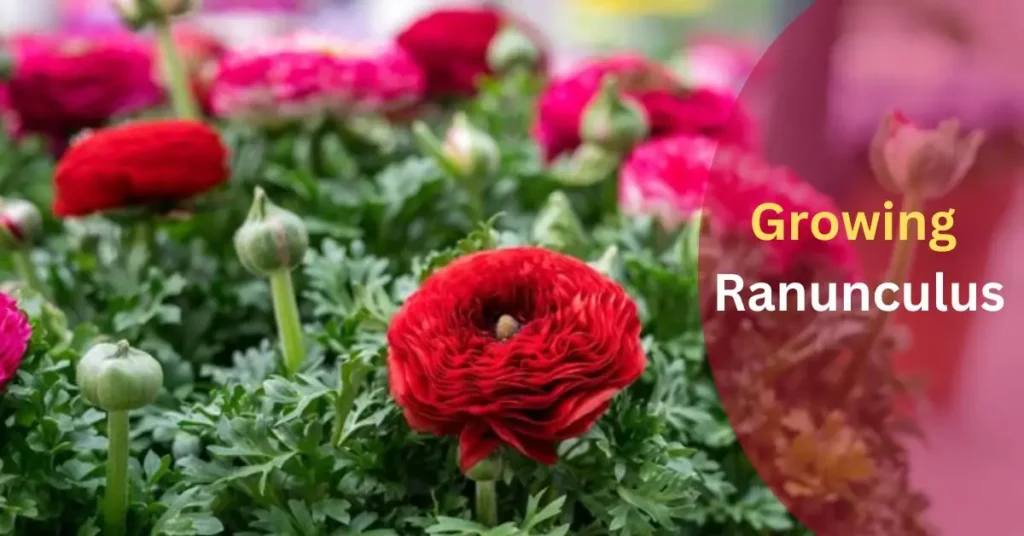Growing ranunculus can be a rewarding experience, whether you’re working with hardy, low-growing varieties or those more delicate, like the Persian buttercups. These perennials are perfect for planting in borders or meadows, and can even thrive at the edge of ponds and streams.
Their satin-like petals bring a touch of elegance to any garden, making them ideal for containers or as bedding plants. If you’re growing alpine ranunculus, you’ll need to provide some specialist care to help them flower well.
When planting ranunculus, they generally need well-drained soil to help them thrive. Although buttercups of all kinds are known to benefit from slightly cooler environments, they still prefer plenty of sunlight and protection from harsh winds. The useful nature of these flowers means they can bloom beautifully, even in challenging locations.
To ensure strong growth and abundant flowers, be sure to give them the proper care, keeping in mind that these plants flourish in conditions where they have ample space to spread their roots and gather nutrients. By following a few simple steps, you can grow these ideal plants with ease, adding a touch of beauty to your garden year after year.
Quick facts
| #- | Quick Facts | Details |
|---|---|---|
| 1- | Ideal Soil | Moist soils that don’t dry out are perfect for growing Ranunculus. |
| 2- | Flowering Time | They typically flower in spring and early summer. |
| 3- | Light Requirements | Buttercups do not thrive in deep shade. |
| 4- | Attracting Pollinators | Meadow and bog buttercups are an early source of nectar, attracting pollinators. |
| 5- | Good for Cutting | Persian buttercups (Ranunculus asiaticus) are great good cut flowers. |
| 6- | Creeping Buttercup | Creeping buttercup (Ranunculus repens) can become a weed in gardens. |
| 7- | Handling | Contact with the sap may irritate the skin, so wear gloves when handling them. |
Before You Get Started

Choosing a Ranunculus
When selecting ranunculus for your garden, it’s important to choose varieties that match your growing conditions. For moist areas with partial shade, try the low-growing, hardy Ficaria verna, a type of ranunculus closely related to the more traditional varieties.
This plant flowers in spring and dies down in summer, making it an excellent choice for border plants or spots that need space for other plants. Lesser celadine (Ficaria verna subsp. verna) can spread like a weed, but it’s an important nectar source for wildlife gardens.
If you’re aiming for moist borders in full sun, consider double-flowered, clump-forming perennials such as Ranunculus acris or Ranunculus aconitifolius, known for their vibrant colours and ornamental foliage. Perennials are plants that live for multiple years, surviving outdoors through winter and providing colourful flowers year after year.
You could also try alpine ranunculus varieties like Ranunculus alpestris or Ranunculus glacialis for rockeries or alpine glasshouses. Look for ranunculus that have earned the RHS Award of Garden Merit to ensure they perform well in your garden.
Buying Ranunculus
When you’re ready to buy ranunculus, you can choose from a variety of options, such as border ranunculus or Persian buttercups, depending on the growing conditions in your garden. Garden centres offer pot grown plants in spring, which can be purchased either in-person or through mail order.
If you’re interested in creating a wild flower meadow, you may find buttercups available as seed or seedlings, which can be grown in small modules and then transplanted with minimal root disturbance. Wildflower seed is often available through specialist suppliers by mail order, though the range may be limited.
For areas with ponds or streams, aquatic nurseries provide pot grown plants like aquatic buttercups, while tubers can be found for plants like Persian buttercups. Tubers are unique as they accumulate nutrients in their enlarged sections, which are typically found beneath the soil.
They also have buds that can grow into new plants.
If you’re planning on growing alpine buttercups, you can find them at specialist alpine nurseries. Remember, some plants may need to be potted up and grown on indoors until they are large enough to plant outside, so be sure to consider the aftercare required for young plants. Click Here to Buy
Planting
When planting perennial ranunculus, it’s important to choose the right garden soil. These plants thrive best in damp soil that doesn’t dry out easily. They prefer sun or partial shade but should be kept away from deep shade, as this can prevent them from flowering.

As hardy perennials, ranunculus can survive the winter and return each year. Their vibrant colourful flowers and ornamental foliage will brighten up any garden, especially when planted in multiple years.
These long-lived, herbaceous perennials will die back to ground level in autumn, unlike trees, shrubs, or sub-shrubs that maintain a woody structure. If planted in the right conditions, perennial ranunculus will grow in various shapes and sizes, and offer a lasting presence in your garden. Just be sure to give them the protection they need during colder months to ensure they survive and thrive outdoors year after year.
In Borders, Meadows, Ponds And Streams Margins
When planting in borders, meadows, or along ponds and streams margins, it’s essential to use the right type of plants for the conditions. You can start with seedlings or young plants grown in small modules, which are easy to transplant with minimal root disturbance.
For bedding plants and veg plants, plug plants are commonly used and come in various sizes. These plants may require aftercare, and it’s a good idea to pot them up and grow them indoors until they’re ready to be planted outside.
For container-grown ranunculus, plant them in spring at the same depth as they were in their pots. If you’re planning to sow seed in meadows, do so in March or April, or in September depending on your soil conditions. Lighter soils benefit from autumn sowing, as the plants can germinate and establish quickly. On heavier soils or waterlogged soils, some seed may rot in winter, so be careful with germination timing.
Bedding And Pot Ranunculus
To get the best results when planting ranunculus in beds or pots, start by soaking the tubers for a day. These swollen underground parts of the stem and root store food for the plant, helping it grow.
After soaking, you can plant the tubers in containers or directly in the ground, ideally from September to December. Make sure to use loam-based compost mixed with peat-free compost, coir, and horticultural grit to improve drainage. Plant the tubers about 10cm (4in) apart and cover them with around 5cm (2in) of compost.
To ensure healthy growth, place the containers in bright light, such as a cool greenhouse or cold frame, and provide good air flow to prevent issues like grey mould and aphids. If you are growing in the garden, select a sunny spot with free-draining soil and add well-rotted compost to retain moisture.
Established plants with strong root systems will thrive in temperatures as low as 0°C (32°F) and can withstand frost once they are well-established. For the best blooms, plant ranunculus in early autumn and wait for their colourful flowers to appear in April.
Unused words: tuberous begonia, cyclamen, dahlia, potato, Persian buttercups, Ranunculus asiaticus, soil improver, decomposed plant waste, compost bin, heap, fertility, structure, water-holding capacity, seed compost, garden compost, slow-release fertilizer, Growmore, claws, downwards, compact plants, delayed flowering.
Alpine Ranunculus
Alpine ranunculus thrive in gritty, humus-rich, and well-drained soils. These plants do best when they get plenty of full sun. If you’re growing them in a scree bed or an alpine house, they’ll be perfectly happy, as these environments mimic their natural habitat.
When planting in pots, a good mix of loam, grit, and leaf mould makes the ideal compost for them. Keep in mind, these hardy plants are known for their resilience but can be somewhat short-lived, so it’s best to plan for their lifecycle.
If you’re looking to grow alpine ranunculus in a container, make sure it has good drainage, and use the right mix to keep the roots happy. A scree bed or alpine house will also give them the ideal conditions to flourish, especially with the well-drained soils they prefer. With proper care, these stunning plants will brighten up your garden, adding a touch of beauty even in the harshest conditions.
Why Are Ranunculuses So Hard To Grow?
Ranunculuses are delicate cool climate plants that thrive best in lower temperatures. These plants are quite sensitive to heat, and when temperatures rise above 70°F, they can face difficulties.

As temperatures rise, ranunculus plants cease producing new buds and enter a dormant phase. This dormancy can make them appear as though they have stopped growing altogether, which can be frustrating for gardeners trying to keep them alive during the warmer months.
To successfully grow ranunculus, it’s important to maintain a cool environment for them. If the temperatures rise too high, you may notice that the plants stop growing, and new buds no longer appear. Managing the climate is key to keeping them healthy and blooming consistently.
Ongoing Care
Watering
When caring for young plants or seedlings that you have grown from seed, it’s important to water them regularly. During the first few months, make sure to keep the top 15cm (6in) of the soil damp, but not soggy.
This allows the plants to grow strong roots and remain healthy. Moist soil is crucial for growing and supporting the plant during its early stages. As the plants start flowering, continue to water them consistently, ensuring the soil stays damp and supports their growth.
This method of watering ensures the plants thrive, and the balance between damp and soggy soil is key to preventing root rot and encouraging steady growth.
Feeding
In early spring, it’s important to give your plants a good start. For plants in borders, use a balanced fertilizer like Growmore or bonemeal to help them grow strong. Apply about 70g per sq m or 2oz per sq yd of the fertilizer to boost plant health and encourage growth.
However, if you have plants growing in meadows or along the edges of ponds and streams, they typically do not need any extra feeding. These plants are typically well suited to their natural soil and environment, need minimal intervention.
I’ve found that regular feeding in spring can really help plants bloom and thrive throughout the growing season. The right fertilizer ensures they get the nutrients they need without becoming too reliant on additional care.
Deadheading
To keep your plants healthy and encourage more blooms, it’s important to remove spent flowers from your alpine and border plants. This simple act of deadheading helps to promote further flowering throughout the season.
To utilize Persian buttercups (Ranunculus asiaticus) in a vase, trim the stems before the petals fully open. By doing this, they will last for about 10-12 days.
Deadheading can be done regularly while growing your plants, especially to keep them looking neat and tidy. It is an easy task that not only helps your plants stay attractive but also encourages them to continue producing more flowers. This practice is particularly helpful for border plants and others that might stop flowering if the old blooms are not removed.
Overwintering
If you’re growing Persian buttercups (Ranunculus asiaticus), you don’t need to worry much about special care during the winter since most ranunculus varieties are quite hardy. However, to ensure they thrive when the cold months arrive, it’s a good idea to grow them in a cool greenhouse during the winter.
This will provide a stable environment that keeps them protected from extreme cold while still allowing them to stay dormant, ready to grow again when the warmer weather arrives. Keep in mind that while they can handle winter, protection from harsh frost can help them bloom stronger in the following season.
If you don’t have a greenhouse, you can also try other methods of overwintering, but make sure to keep them in a sheltered spot, out of direct frost, ensuring they are not exposed to conditions that might harm their growth.
Caring For Older Plants
When it comes to caring for older plants, some plants like Ranunculus repens and Ficaria can spread rapidly in your garden, sometimes becoming a nuisance. To prevent these plants from taking over, it’s important to manage their growth.

If you have early flowering plants such as Ficaria, they may die down in summer, leaving you wondering where they went. A good tip is to place a plant label under the plant so you can easily identify it later if you accidentally dig in the wrong spot.
In the case of Persian buttercups (Ranunculus asiaticus), these are best treated as annual plants, as they are generally replaced with new ones every year. By doing this, you ensure that your garden stays healthy and vibrant without overcrowding from older plants.
Propagating
Methods of Propagating Perennials
When propagating perennials such as Ficaria, ranunculus, or Persian buttercups (Ranunculus asiaticus), there are several methods you can use to grow new plants. For those that flower in spring or autumn, cuttings taken from the stem, root, leaf, or bud can help you create new plants.
You can also use seed from these herbaceous plants, but it’s important to know that germination can take time, especially for plants in winter dormancy. Frost-free conditions in a cold frame or sheltered space are ideal for sowing the seeds.
Use a gritty, loam-based compost to ensure good drainage, and keep the soil moist as the seeds start to sprout. For hardy varieties like water crowfoot (Ranunculus aquatilis) or greater spearwort (Ranunculus lingua), you can divide the plant in autumn or spring to increase the number of new plants.
Caring for Propagated Plants
Propagating is a great way to maintain and expand your garden. By dividing or taking cuttings, you can produce new plants with well-established root systems. For plants like Persian buttercups, growing from seed may take a little longer, but it’s a rewarding process when you see them bloom.
Thekey to successful propagating is to provide the right temperature and conditions for growth, and be patient as the new plants develop and gain strength. This method not only helps you get more plants but also conserves energy and resources from your existing plants.
Problems
Ranunculus plants are generally trouble-free, but there are a few problems that can arise under certain conditions. One common issue is powdery mildew, which occurs in dry conditions.
To prevent this, ensure good air circulation, especially when growing plants in cold frames or greenhouses. Without proper airflow, grey mould can develop, leading to unhealthy plants. Additionally, pests like aphids can be a concern, especially in humid environments.
Another issue to consider is the spread of some Ranunculus varieties, which can grow rapidly and may need to be reduced to avoid overcrowding.Lesser celandine may pose challenges if it is not properly managed.
It’s essential to monitor the growth and act promptly to manage these issues and maintain a healthy garden.
When To Plant Ranunculus Zone 7
In Zone 7, timing is key when planting ranunculus. These plants are quite sensitive to temperature fluctuations, so it’s essential to plant them at the right time to ensure they thrive. The best time to plant pre-sprouted ranunculus corms is in early spring, typically a week or two before the last frost date. This allows them to settle in before the warmer temperatures arrive, giving them the best chance for growth and blooming.

Preparing the Soil for Ranunculus
Before planting, ensure the soil is well-draining. Ranunculus corms prefer soil that doesn’t stay soggy, as they are prone to rot in overly wet conditions. Dig a hole about 2 inches deep to plant the corms, which should be placed with the pointed end facing up. It’s important to space them a few inches apart to allow for their growth and root development. A good tip is to mix in some organic matter to improve the soil’s texture and drainage, giving your ranunculus the best start.
Temperature Considerations for Blooming
One thing to note is that ranunculus is sensitive to heat. Once temperatures rise above 80°F, the plants will stop blooming. This is why planting them early in spring is important, as it gives them time to establish and bloom before the heat of summer sets in. Keep track of the weather, and once the last frost date has passed, you can expect your ranunculus to bloom beautifully as long as the temperatures remain favorable.
Special Tips for Zone 7 Gardeners
In colder climates, such as Zone 7, it’s essential to plant your pre-sprouted ranunculus early to avoid the frost damage that can occur if they are planted too late. Keep an eye on spring weather patterns, as early planting allows the corms to establish a strong root system before any potential late frosts. Using cold frames or row covers can help extend the growing season if the weather remains chilly into early spring.
When To Plant Ranunculus Zone 6
In USDA zone 6, the best time to plant ranunculus is typically in the fall. However, the exact timing depends largely on your specific microclimate. It’s essential to consider local weather patterns when deciding the right time to plant. Before planting, you should soak the corms in room temperature water for 2–4 hours. This soaking process helps the corms swell in size and gives them a head start, improving their chances of healthy growth. This step is especially important for ranunculus as it helps them establish quicker once planted.
Soil and Planting Depth
Once the corms have been soaked, plant them in well-draining soil that receives full sun.Create holes with a depth of approximately 2 to 3 inches, ensuring that the corms are positioned 6 to 9 inches apart from one another.
When planting, place the pointed end of each corm facing down to encourage proper growth.
Frost Protection
Ranunculus can tolerate temperatures as low as 23°F, but if temperatures are expected to dip into the low 20s for multiple nights, it’s a good idea to cover the plants To protect them from the cold, use a frost cloth. In colder climates, consider planting your ranunculus in a hoop house. This provides some protection from the harshest winter temperatures while still allowing them to grow in a minimally heated environment.
Blooming and Growth
As the ranunculus begin to grow, they will bloom in about 90 days and will continue flowering until temperatures rise above 80°F, at which point they will stop blooming. The stunning flowers feature layers of papery petals in various colors, making them a beautiful addition to any garden. Whether planted in the ground or in a protected area, these flowers can add vibrant hues to your garden in spring, as long as they are planted at the right time and cared for properly.
Growing Ranunculus From Seed
Sowing Ranunculus Seeds
To grow ranunculus from seed, the best time to sow is during late summer or early autumn. If you’re using lighter soils, sowing in the autumn will help the plants germinate quickly. You should choose a well-draining potting mix to sow the seeds in trays, punnets, jiffy pots, or soil starter pellets. To start the seeds, plant them 2 mm deep and cover lightly. Keep the soil moist but not too wet or dry for optimal germination.
Germination and Transplanting
Seeds should germinate in 10–15 days if the soil temperature is between 18–20°C. Be mindful that too much heat can slow down the germination process. Once the seedlings have their first true leaves and are large enough to handle, you can transplant them to the garden. Space the plants about 20 cm apart for healthy growth.
When transplanting, ensure that the seedlings are hardened off by gradually moving them outside for a few hours each day. During hot weather, protect the plants as ranunculus are cool climate plants that stop producing new buds when temperatures rise above 70°F. Lastly, during cold stretches, use frost cloth to protect your plants from the frost.
FAQs
Yes, ranunculus can be easily grown in pots! Each corm needs about 15cm of growing space, so choose a pot that fits the number of corms. The pot should be at least 30cm deep to allow enough room for the roots. Ensure the pot has plenty of drainage holes to prevent waterlogging. Giving the corms enough space to grow will keep them healthy and thriving.
The ideal time to plant ranunculus is in late winter or early spring to avoid frost damage, as these plants are sensitive to cold. In milder or warmer regions, you can also plant in autumn for a better chance of growth.
Ranunculus plants need bright light every day to thrive. They should be grown in full sun, especially in cool weather. However, in hot climates, they may require sun protection during the hottest part of the day. With the right balance of sunlight, these plants will flourish and bloom beautifully.
Ranunculus flowers have a vase life that can last more than 10 days if picked at the right time. When you cut them, make sure the buds are colored and feel squishy, like a marshmallow, but not fully open. This way, they can last anywhere from 10 to 12 days in a vase. If you cut them after the blooms are open, they will still last for a week, but they will be more fragile and may not handle transport as well.
Conclusion
Growing ranunculus can be a rewarding and visually stunning addition to your garden, providing vibrant blooms that enhance borders, meadows, and containers. Whether you are cultivating hardy varieties like Ficaria verna or the more delicate Ranunculus asiaticus (Persian buttercups), understanding the plant’s specific needs is crucial for success.
Ranunculus thrives in well-drained, moist soil and requires ample sunlight, making it ideal for gardens with bright, sheltered spots. Although they are somewhat sensitive to heat,
See Also:
Can You Apply Too Much Preen to Your Plants? 5 Risks
How Long Does It Take to Grow Bell Peppers in Minnesota? A Complete Guide



